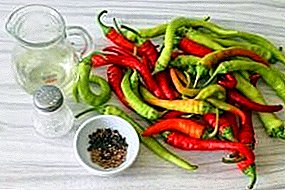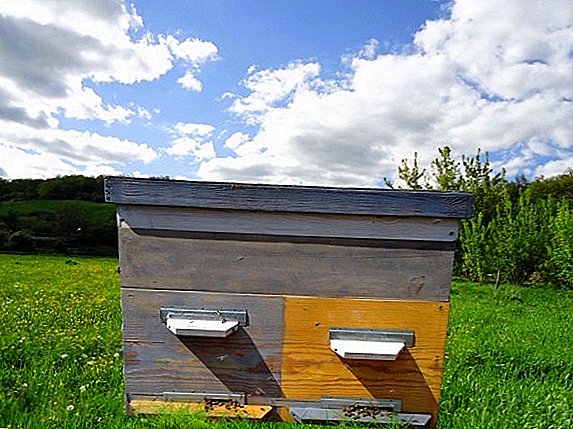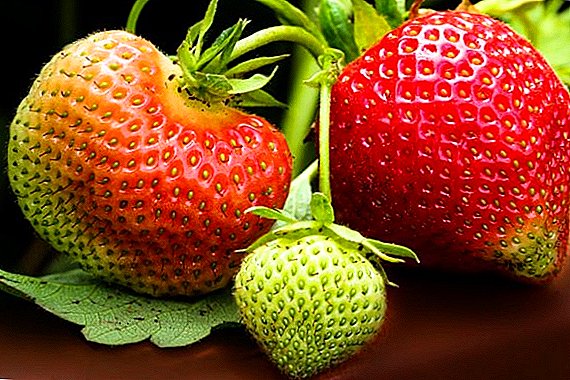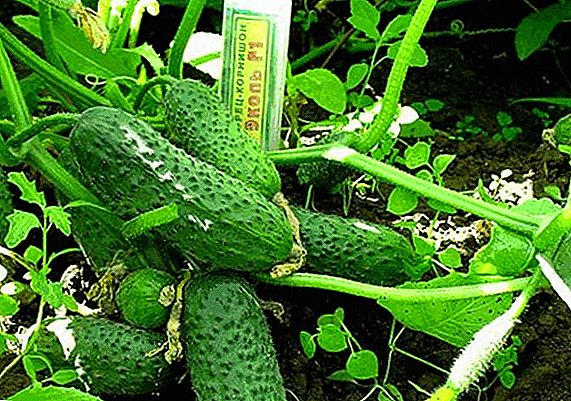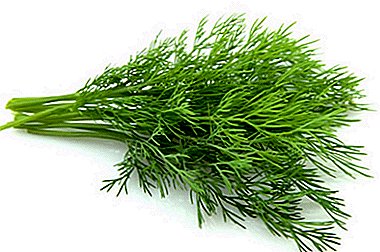 The process of breeding poults with an incubator is a work with a special regime, in which viable and healthy chicks come to this world.
The process of breeding poults with an incubator is a work with a special regime, in which viable and healthy chicks come to this world.
Incubator selection
Farmers-poultry farmers have noted for a long time the fact that with the proper incubation of turkey eggs, more chicks appear (as a percentage) than with natural incubation by the female (often turkeys part of the clutch is crushed by their weight).  Incubator for turkey eggs differs in features such as:
Incubator for turkey eggs differs in features such as:
- heating comes from the top of the unit;
- heating comes from the bottom of the unit.
But both of these systems are imperfect, as the masonry is heated unevenly. Many poultry farmers are trying to improve their units, trying to get closer to the natural conditions.
Dilution of chickens, quails, ducks, hawks can also be carried out using an incubator.
The main differences of one device from another is:
- how much the machine is designed for;
- manual or automatic control of the incubator;
- how easy the unit is to use.
 For the most efficient breeding of poults in an incubator at home, the following parameters should be considered:
For the most efficient breeding of poults in an incubator at home, the following parameters should be considered:- adjustment of the air exchange process and air humidity in the incubator;
- regulation and monitoring of the air temperature inside the device;
- timely turns of eggs, their cooling and spraying;
- incubation time.
Did you know? The first incubator in Europe was created by the Italian D. Porto. He first applied as a heating lamp.
The best breeds
For breeding turkeys in the incubator, there are not many breeds, the best of them are:
- North Caucasus bronze. The bird reaches adulthood at 9 months. At this age, the female weighs 7 kg, the weight of the male reaches 14 kg. The egg production of the female of this breed is up to 80 pieces per year.
- North Caucasian white. The bird reaches adulthood at 9 months. By this time the female weighs 7 kg, and the weight of the male reaches 14 kg. The egg production of the female of this breed is up to 180 pieces per year.
- Bronze wide breasted. Externally, the bird is similar to representatives of the North Caucasus breed, but it has differences in terms of weight: females - 8 kg, males up to 15 kg.
- White wide-breasted. This breed is kept to produce high quality meat. Female egg production is up to 120 pieces per year.
- Moscow white and Moscow bronze. Eggs begin to carry at the age of 6 months and bring up to 100 pieces in a year.
- Heavy cross big-6. Breed with exceptional meat qualities, the weight of the bird sternum is 30% of the total weight of the carcass. The adult female weighs about 11 kg, and the weight of the male reaches 25 kg.






Did you know? In the course of research on breeding chicks in an incubator, it was observed that with simultaneous placement of egg clutches from north to south and east to west, in the first version, chicks appeared earlier.
The right choice of eggs
When choosing a turkey hatching egg for further breeding, it is necessary to pay attention to the following conditions:
- for breeding chicks in an incubator, it is necessary to purchase raw materials from females that have reached the age of eight months;
- It is advisable to purchase incubation material that was torn down during the spring, as the poults do not tolerate cold;
- Before laying the testicles in the incubator, it is necessary to subject them to a thorough inspection. They must have the correct form, with a smooth structure of the shell, homogeneous, without inclusions and growths;
- eggs for an incubator should be medium-sized, since small or excessively large eggs have a low hatchability rate;
- it is necessary to check the location of the yolk by radiating. The yolk should be centered, should not have a clear outline, and in the stupid edge should be an air chamber;
- during ovoskopirovaniya when turning the eggs, the yolk, located inside, should move slowly;
- dirty eggs are subject to rejection;
- reject eggs are two yolks.
Important! Eggs for incubation can not be stored in the refrigerator.The laying intended for an incubation can be stored no more than 10 days, thus the temperature should correspond + 12 ° С and the level of humidity 80%. The room should be dry and without access to sunlight.
 Eggs with minor contamination are cleaned from dirt (do not wash) and stored in a dry clean place, laying out so that the blunt end is at the top. It is necessary to turn the eggs every fourth day, this operation is necessary for the normal development of embryos.
Eggs with minor contamination are cleaned from dirt (do not wash) and stored in a dry clean place, laying out so that the blunt end is at the top. It is necessary to turn the eggs every fourth day, this operation is necessary for the normal development of embryos.How to grow turkey poults
In the farming and household breeding of turkeys is popular. This is not surprising, because this bird is distinguished by gentle fluff, delicious meat and delicious eggs. There are two ways to get poults: put a hen turkey on a clutch or lay them in an incubator. Breeding young stock with an incubator is quite popular among breeders.
Important! Every day, egg storage reduces the percentage of hatchability.
Egg laying
Before placing the clutch in the incubator, it is necessary to disinfect it and disinfect the apparatus itself, in order to prevent infections in the chicks in the future. Disinfectant can be purchased at pharmacies, and you can prepare an aqueous solution of potassium permanganate.
Dip eggs into disinfection solution should not, simply wipe with a cloth moistened with this solution, let them dry naturally. Turkey eggs are placed in the incubator only when they are warmed to room temperature. The loading of the masonry into the incubator may be vertical or may be horizontal, it all depends on the model and brand of the device. When laying in a horizontal way, do not forget to make a marker on the shell in the upper part of the testicles, this should be done in order to avoid confusion in the future, when you start to turn them over.  When laying in a vertical way, place the eggs in the tray with the pointed side down, keeping an angle of 45 °.
When laying in a vertical way, place the eggs in the tray with the pointed side down, keeping an angle of 45 °.
Learn how to achieve high productivity turkeys.
Conditions for incubation
Incubation of the clutch should be carried out under the tireless control of the poultry farmer and be accompanied by timely translucence through the ovoscope. Translucence is performed on the 8th, 13th and 26th day.  8 day. On this day, the first stage of brood incubation ends. The developed circulatory system is well visible inside the egg. The embryo is not visualized, as it is completely in the yolk. At the place where the embryo should be, there is a zone lighter than the rest of the yolk. If during translucence there is a dark blotch (blood ring), then this means that the embryo has died and must be disposed of.
8 day. On this day, the first stage of brood incubation ends. The developed circulatory system is well visible inside the egg. The embryo is not visualized, as it is completely in the yolk. At the place where the embryo should be, there is a zone lighter than the rest of the yolk. If during translucence there is a dark blotch (blood ring), then this means that the embryo has died and must be disposed of.
13 day. The clear contour of the embryo is visible, in the sharp end of the egg there is a closed allantois. A clear mesh of the vessels, which is closed at the sharp end, is visualized. Dead embryos look like a blurry spot, easily moving from side to side, such eggs are utilized.
26 day The embryo occupies all free space, the air chamber is large in size. The movement of the chick is clearly visible, you can see how the neck bulges. If movements are not visible, then the embryo is frozen and must be disposed of.
| Period | Required temperature | Required moisture level | Necessary manipulations |
| First 3 days | 38-38.3 ° C | 60-65% | 6-12 coups |
| from 10th day | 37.6-38˚C | 45-50% | airing the incubator twice a day for 10 minutes, 6 coups |
| 4-14 days | 37.6-38˚C | 45-50% | 6 coups |
| 15-25 days | 37-37.5 ° C | 60% | airing the incubator three times a day for 15 minutes, making coups at least 4 times |
| 26-28 day | 36.6-37˚C | 65-70% | no turning and airing |
When to expect chicks
The period of incubation of turkey eggs at home is 28 days. The first babies can appear already on the 25-26 day, and at the end of the 27th - the beginning of the 28th day turkeys appear en masse.  Do not often look into the incubator, checking at what stage of the process - you can chill already appeared wet chicks. Before removing the chicks from the incubator, make sure they are completely dry. If the hatching was delayed in time longer than 8 hours, it is recommended that chicks be dredged twice, completely dried at first, and later belated.
Do not often look into the incubator, checking at what stage of the process - you can chill already appeared wet chicks. Before removing the chicks from the incubator, make sure they are completely dry. If the hatching was delayed in time longer than 8 hours, it is recommended that chicks be dredged twice, completely dried at first, and later belated.
Popular mistakes beginners
The most common mistakes of novice poultry farmers are as follows:
- Non-compliance with the temperature regime during the withdrawal of poults in the incubator at home.
 In case of insufficient temperature, a small fraction of the surviving chicks is born later than the established period. They are sedentary, with weakened limbs, the down grows unevenly and has a dirty look.
In case of insufficient temperature, a small fraction of the surviving chicks is born later than the established period. They are sedentary, with weakened limbs, the down grows unevenly and has a dirty look.- Non-observance of humidity.
Humidity in abundance. The chicks have a dirty, fallen down fluff; some of the chicks are lost from drowning in the amniotic fluid. Such young animals are born after the deadline.
- Noncompliance with the number of revolutions of turkey eggs.

Incubator: advantages and disadvantages of the method
The main advantage of breeding turkey poults in an incubator at home is the possibility of obtaining young during the whole year, but in addition it has following advantages:
- the simultaneous appearance of a large number of chicks;
- with all the rules of breeding - 85% of the eggs laid in turn into chicks;
- a large selection of models of incubators on the market allows you to choose the desired option;
- the cost of the device is relatively low, the unit can pay off in several applications.
 The disadvantages of the incubator include the following:
The disadvantages of the incubator include the following:- in case of interruptions in the operation of the device, you can ruin the entire offspring or get it in much smaller quantities than planned;
- it is necessary to control the temperature stability; in incubators, thermal sensors are the most replaceable parts during repair work;
- carrying out thorough disinfection apparatus.




